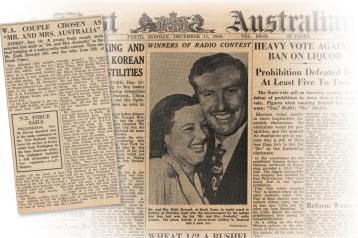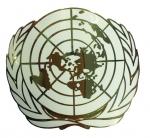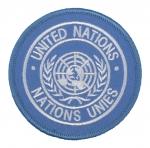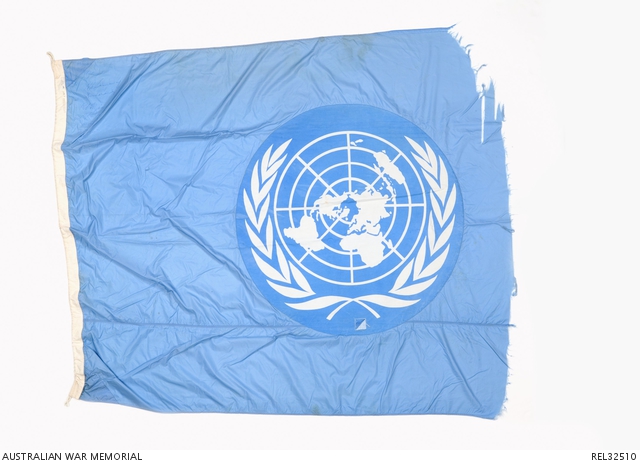Colonel Keith Howard
Keith Desmond Howard spent his childhood on the outskirts of Perth. Born in November 1920, he grew up enjoying the sunshine and exploring and playing in the local bushland with other neighbourhood children. He went to school in a multicultural area. Many of Keith’s classmates were of British, Italian, or Greek origin, or of the Jewish faith. He left school aged 15, as was common at the time, to work as a bank clerk. However, he longed for adventure and subsequently joined the Militia as a part-time soldier.
When the Second World War began in 1939, Keith was keen to join the Second Australian Imperial Force (AIF), and he was eventually transferred from the Militia to the 2/16th Battalion. Soon he was travelling to the Middle East, where he would see action in the Syrian campaign, and later he served on Borneo in south-east Asia. When the war was over Keith returned to Perth and worked for his father’s company, while continuing to serve as a reservist in the military. He also fell in love.
Keith married Joan Kathleen Warren in 1947. Joan was a war widow with two young daughters. She had served as a nursing orderly in the Voluntary Aid Detachment during the war, until her marriage to an RAAF pilot named Anthony in 1943. Anthony had died on war service in 1945, aged 24.
A Mothers’ and Widows’ Badge with a single star, representing the death of one relative, c. 1942.
When Keith married Joan he adopted her children, and soon they welcomed a daughter. By 1966 Keith’s older children were entering adulthood, and he had been promoted to the rank of colonel. Despite experiencing the horrors of war, Keith was drawn to the sense of duty, the social life, and the opportunity to travel that he had encountered in the army. After enquiring about possible overseas postings he was assigned a position as a military observer with the UN Truce Supervision Organisation (UNTSO) in the Middle East. His family were surprised by his posting, but not opposed to it. Joan shared Keith’s adventurous spirit, and was excited at the prospect of living overseas. In 1967 Keith, Joan, and their youngest daughter left Australia, bound for Jerusalem.

In 1950 there was a nationwide radio contest to find “Mr and Mrs Australia”. Approximately 15,000 couples entered, and Joan and Keith won. They were awarded a seven-week visit to England, a new car, and new wardrobes, as well as music lessons for their children. (Images courtesy of the National Library of Australia, 48140645)
Keith flew ahead of Joan, and went to work on 5 June 1967, which turned out to be the start of the Six-Day War between Israel and its surrounding Arab states. The UNTSO headquarters came under attack, as its vantage point made it strategically useful to the Israeli soldiers. Keith and other UN staff, women, and children took shelter in a room, lying low on the ground for safety. Ultimately, the firing stopped and Keith assisted his colleagues with the evacuation of people and records. However, he had not escaped unharmed. In one of his thighs a bullet or piece of shrapnel had lodged, and he was bleeding heavily. Luckily, the wound turned out to be minor, and a doctor suggested the object would work itself out of his leg, so there it remained.
This flag was flown over UN headquarters in Jerusalem at the start of the Six-Day War, c. 1960–1967.
Joan’s ship had been diverted as it travelled to the Middle East, and she heard of the incident mid-journey. Keith later explained:
"The war in 1967 broke out … the ship couldn’t go through the Suez Canal as it was intended to. Had to take a long trip round Africa in through Gibraltar and Joan got a message in Gibraltar from her father that her husband Major Keith Howard had been wounded or had been shot … Marvellous. Anyway eventually she arrived in Beirut and was very glad to see me on the wharf waiting to greet her."[1]
Despite a dramatic beginning, Keith, Joan, and their daughter soon settled into life in the Middle East. The political and military situation remained unstable in the region, and Keith’s job often took him up to the ceasefire line. Joan recollected that on those occasions “I had to burn his clothes because you know you can just smell death”.[2] Joan rented apartments with short-term leases, as Keith was required to move frequently for work. She looked for homes that were close to the ceasefire line so that he could return home easily.
Along with other UNTSO wives, Joan fostered a sense of normalcy within the UN community. Families met regularly for social activities like tennis, card games, and language lessons. This was important to them, especially as they were discouraged from developing relationships with local people so as to avoid affecting their impartiality. However, Joan did recall a caring act of her local cleaning man during a dangerous period in Gaza:
One night there was a lot of blowing up and he did not return to his refugee camp at five o’clock, he just disappeared so I thought “oh he’s gone to the camp as usual” … anyway it was pretty bad and I didn’t know until that morning that kind man slept on the floor outside my door all night, because I think he thought … “maybe she’s scared, maybe I can help” which was very kind, very kind.[3]
Keith (left) with other UN military observers from Canada and Denmark, and a member of the Israeli army, in Syria, 1968.
Keith and Joan remained in the Middle East for around ten years. In that time Keith held a variety of command positions, including Acting Chief of Staff of UNTSO. In later years he reflected on his military service:
I’ve, I think, achieved something, I’ve contributed to the wellbeing of various groups of people, I’ve been able to do this with the wonderful support of my wife and my family who have to some degree participated in the pleasures and the dangers and the excitements – so it’s been a wonderful family life.[4]
Activities
- Blue berets (or helmets, armbands, and shoulder patches) are worn by UN peacekeepers worldwide. Blue and white are the official UN colours
- Noting the blue berets in the photograph below, why might the UN have chosen this colour?
- Brainstorm a list of jobs that peacekeepers may do. Further information can be found on the United Nations peacekeeping website.
Australian peacekeepers talk to children in Rwanda, 1994. (Geoffrey Fox)
- What symbols do you recognise on the UN beret badge and UN shoulder patches below? What do these symbols represent?
- Design your own uniform for modern peacekeepers. What colours, patterns, symbols, and materials will you consider? Why? Will the uniform be suitable for all service people from across the world, or just for Australians?


- The below photograph of Joan Howard was taken in 2016. This was part of a project called “Reflections: honouring Australian Second World War veterans”. Between 2015 and 2017, 450 photographers from around Australia took images of 6,500 Second World War veterans.
- Why do you think Joan wore her service medals, and her Mothers’ and Widows’ Badge for the photograph?
- As family members of a UN peacekeeper, Joan and her daughter moved to the Middle East. Write a letter from their perspective, explaining some of the challenges and new experiences they might have encountered.
Related objects
Footnotes
[1] Australians at War Film Archive, “Keith Howard”, accessed 20 February 2019. Reproduced with permission.
[2] Interview with Joan Howard, 18 August 2003 (AWM S02157).
[3] Interview with Joan Howard, 18 August 2003 (AWM S02157).
[4] Imperial War Museum, “Howard, Keith D. (oral history)”, accessed 20 February 2019. Reproduced with permission.
Bibliography
“About UNTSO”, accessed 20 February 2019.
Oral history sound recording of Colonel Keith Howard, 2003, AWM S02155.
Peter Londey, “Observer at large”, Wartime 27, July 2005.
“WA couple chosen as ‘Mr and Mrs Australia’”, The West Australian, 11 December 1950. Images courtesy of the National Library of Australia, 48140645.
Warren, Anthony Graham, service records, National Archives of Australia, A705, 166/43/1299.





